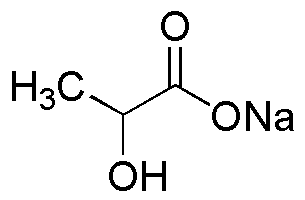DL-Lactic acid sodium salt, 60% w/w syrup is widely utilized in research focused on:
- Food Industry: This compound serves as a preservative and flavoring agent, enhancing the taste and shelf life of various food products.
- Pharmaceuticals: It is used in drug formulations to improve solubility and stability, making medications more effective and easier to administer.
- Cosmetics: The compound acts as a pH regulator and moisturizing agent in skincare products, promoting skin health and enhancing product performance.
- Biotechnology: It plays a crucial role in fermentation processes, aiding in the production of biofuels and biodegradable plastics, which are environmentally friendly alternatives.
- Animal Feed: As a feed additive, it improves gut health and nutrient absorption in livestock, leading to better growth rates and overall animal well-being.
General Information
Properties
Safety and Regulations
Applications
DL-Lactic acid sodium salt, 60% w/w syrup is widely utilized in research focused on:
- Food Industry: This compound serves as a preservative and flavoring agent, enhancing the taste and shelf life of various food products.
- Pharmaceuticals: It is used in drug formulations to improve solubility and stability, making medications more effective and easier to administer.
- Cosmetics: The compound acts as a pH regulator and moisturizing agent in skincare products, promoting skin health and enhancing product performance.
- Biotechnology: It plays a crucial role in fermentation processes, aiding in the production of biofuels and biodegradable plastics, which are environmentally friendly alternatives.
- Animal Feed: As a feed additive, it improves gut health and nutrient absorption in livestock, leading to better growth rates and overall animal well-being.
Documents
Safety Data Sheets (SDS)
The SDS provides comprehensive safety information on handling, storage, and disposal of the product.
Product Specification (PS)
The PS provides a comprehensive breakdown of the product’s properties, including chemical composition, physical state, purity, and storage requirements. It also details acceptable quality ranges and the product's intended applications.
Certificates of Analysis (COA)
Search for Certificates of Analysis (COA) by entering the products Lot Number. Lot and Batch Numbers can be found on a product’s label following the words ‘Lot’ or ‘Batch’.
*Catalog Number
*Lot Number
Certificates Of Origin (COO)
This COO confirms the country where the product was manufactured, and also details the materials and components used in it and whether it is derived from natural, synthetic, or other specific sources. This certificate may be required for customs, trade, and regulatory compliance.
*Catalog Number
*Lot Number
Safety Data Sheets (SDS)
The SDS provides comprehensive safety information on handling, storage, and disposal of the product.
DownloadProduct Specification (PS)
The PS provides a comprehensive breakdown of the product’s properties, including chemical composition, physical state, purity, and storage requirements. It also details acceptable quality ranges and the product's intended applications.
DownloadCertificates of Analysis (COA)
Search for Certificates of Analysis (COA) by entering the products Lot Number. Lot and Batch Numbers can be found on a product’s label following the words ‘Lot’ or ‘Batch’.
*Catalog Number
*Lot Number
Certificates Of Origin (COO)
This COO confirms the country where the product was manufactured, and also details the materials and components used in it and whether it is derived from natural, synthetic, or other specific sources. This certificate may be required for customs, trade, and regulatory compliance.


